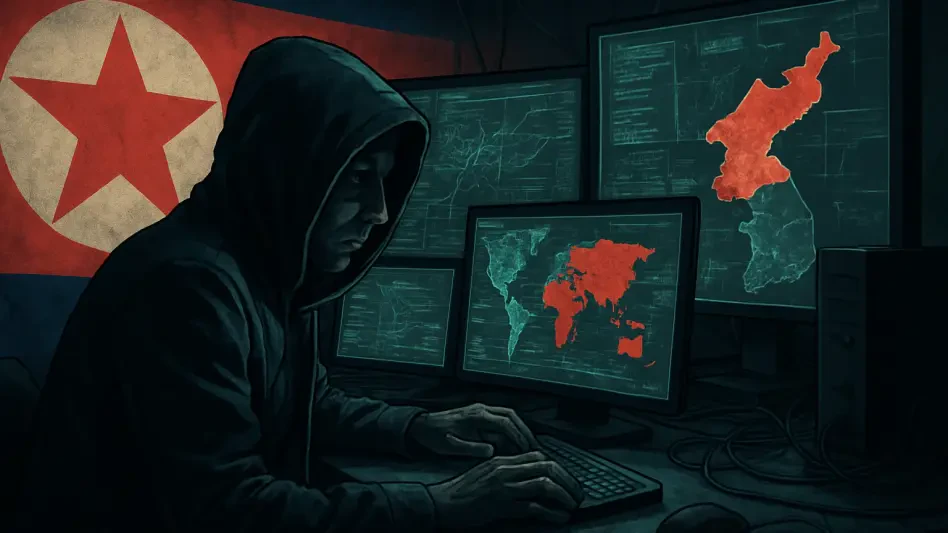In a shadowy corner of the digital world, a sophisticated cyber espionage campaign has emerged, targeting foreign embassies with chilling precision, and raising critical questions about the security of diplomatic communications. A North Korea-linked hacker collective, known as the Kimsuky group or APT43, has orchestrated an ongoing operation that has already compromised at least 19 embassies and foreign ministries in South Korea. Unveiled by a recent cybersecurity report, this campaign showcases the alarming intersection of deception and technology. As state-sponsored cyber threats grow more intricate, the methods employed by these hackers reveal a calculated effort to exploit trust and infiltrate sensitive systems, posing a significant challenge to global diplomatic infrastructure.
Unveiling the Cyber Espionage Campaign
Tactics of Deception in Diplomatic Phishing
The Kimsuky group’s latest operation hinges on an elaborate web of deception, primarily through phishing emails that mimic legitimate diplomatic correspondence. These messages are crafted with meticulous detail, often impersonating foreign diplomats or referencing real events to lure unsuspecting recipients. For instance, emails may pose as invitations to high-profile embassy events or urgent communications from European officials, complete with official signatures and diplomatic terminology. Hidden within these emails are malicious attachments, frequently disguised as password-protected ZIP files masquerading as PDFs. Once opened, these attachments deploy a variant of XenoRAT malware, a powerful open-source remote access trojan that grants attackers full control over infected systems. This includes capabilities like keystroke logging, webcam access, and data theft, often routed through platforms like GitHub to evade detection, highlighting the hackers’ cunning use of trusted digital spaces.
Beyond the technical sophistication, the campaign’s success lies in its exploitation of human trust. The emails are tailored to specific targets, incorporating cultural and linguistic nuances in languages such as Korean, English, Persian, Arabic, French, and Russian. This level of customization demonstrates a deep understanding of the diplomatic community’s communication norms, making it incredibly difficult for even cautious individuals to spot the fraud. Additionally, the hackers leverage widely used services like Dropbox, Google Drive, and Korea-based Daum to host their malicious files, blending into the digital noise of everyday tools. This strategic adaptability not only increases the likelihood of a successful breach but also underscores the growing challenge of distinguishing genuine correspondence from malicious intent in an era where digital diplomacy is paramount.
Operational Patterns and Geopolitical Intrigue
One of the most puzzling aspects of this campaign is the operational timing of the Kimsuky group, which curiously aligns with Chinese working hours and pauses during Chinese national holidays rather than those of North or South Korea. This unusual pattern has sparked speculation among cybersecurity experts that the group may be operating from Chinese territory or possibly collaborating with contractors based there. While the attribution to North Korea remains firm, this anomaly introduces a layer of geopolitical complexity, suggesting potential cross-border collaboration or outsourcing in cyber operations. Such dynamics hint at a broader network of state-sponsored cyber activities that transcend traditional national boundaries, complicating efforts to pinpoint and counter these threats effectively.
Further deepening the intrigue, historical context shows that North Korean cyber units often operate from abroad, including regions like China and Russia, to bypass international restrictions. This aligns with observations from cybersecurity analyses and statements from U.S. officials regarding the global footprint of such groups. The possibility of operating from foreign soil or engaging with external partners raises questions about accountability and the true scope of these cyber espionage efforts. As diplomatic entities grapple with these invisible adversaries, the blurred lines of geopolitical alliances in cyberspace add another dimension to the challenge of securing sensitive communications against persistent and resourceful attackers.
Broader Implications and Historical Context
A Legacy of Cyber Intrusions by Kimsuky
The Kimsuky group is no stranger to the world of cyber espionage, having been active for over a decade with a track record of targeting a wide array of entities. Governments, think tanks, academics, and media organizations across Asia, Europe, Japan, Russia, and the United States have all fallen into their crosshairs. Their activities are often tied to gathering intelligence to bolster North Korea’s foreign policy objectives and support efforts to evade international sanctions. In recent years, sanctions imposed by the U.S. and Pacific allies have underscored the group’s role in state-sponsored cyber operations, marking them as a significant threat to global security. This longstanding pattern of intrusion reveals a persistent and evolving adversary focused on high-value targets with strategic importance.
Delving deeper into their methods, the group’s ability to refine tactics over time is evident in the current campaign. From rudimentary phishing attempts in earlier years to the highly sophisticated, culturally tailored attacks seen today, Kimsuky has adapted to the changing digital landscape. Their use of advanced malware like XenoRAT and exploitation of trusted platforms reflect a maturation of skills aimed at maximizing impact. This evolution mirrors a broader trend among nation-state actors who continuously hone their approaches to exploit vulnerabilities in both technology and human behavior. For diplomatic institutions, this history serves as a stark reminder of the relentless nature of such threats and the need for vigilance against an enemy that learns and adapts with each operation.
Rising Sophistication in State-Sponsored Threats
The escalating sophistication of state-sponsored cyber espionage, as exemplified by Kimsuky’s recent activities, signals a troubling trend for global security. Attackers are increasingly exploiting the inherent trust in official communications to penetrate sensitive systems, a tactic that proves particularly effective against diplomatic targets. The precision with which phishing content is crafted—often mirroring real-world events and leveraging multiple languages—demonstrates a nuanced understanding of their targets’ environments. This level of detail not only increases the success rate of attacks but also highlights the growing difficulty of safeguarding critical infrastructure in a digitally connected world where trust can be weaponized.
Reflecting on the wider implications, this campaign underscores the urgent need for enhanced cybersecurity measures within diplomatic circles. The potential involvement of foreign territories or contractors in these operations adds a geopolitical layer to the threat, suggesting that cyber warfare may involve complex networks beyond a single state’s borders. As nation-state actors like Kimsuky continue to refine their strategies, the challenge of distinguishing legitimate communications from malicious ones becomes ever more daunting. Looking back, the persistent targeting of embassies in Seoul revealed a critical vulnerability in digital diplomacy, prompting a renewed focus on developing robust defenses and international cooperation to counter such intricate and enduring cyber threats.








